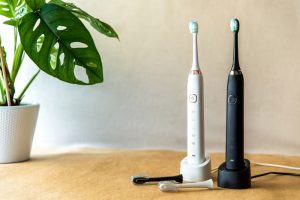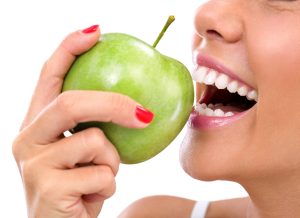

Avoid Gum Disease and Smile Confidently
Whether you’re flashing a smile in pictures or enjoying your favorite meal, healthy gums play an indispensable role. They’re the unsung heroes often overlooked while fighting against bacteria and anchoring our teeth in place. Healthy gums can transform not just your oral health, but overall wellbeing too.
Our Staten Island dentists have put together this comprehensive step-by-step guide so you can discover the secrets of achieving and maintaining gum health, ensuring that your smile remains vibrant for years to come. Say goodbye to bleeding and sore gums!
 Correct Brushing and Flossing Techniques
Correct Brushing and Flossing Techniques
Maintaining healthy gums goes far beyond a simple swipe of the toothbrush or a quick floss. It requires adopting correct techniques that effectively remove plaque and protect your gums.
Brush With Precision
When it comes to brushing your teeth, use a soft-bristled toothbrush and fluoride toothpaste, and position the brush at a 45-degree angle against your gums. Move the brush gently in short strokes, making sure to clean every surface of each tooth. Pay close attention to the gumline, where plaque tends to accumulate. Aim for at least two minutes of brushing, both morning and night.
Floss Like a Pro
Flossing is essential for a complete oral care routine, as it removes plaque and food particles from between teeth and below the gum line. To floss correctly, cut off about 18 inches of floss and hold it tightly between your thumbs and forefingers. Gently slide it up and down between your teeth, following the curve of each tooth, in a C shape. Make sure to clean beneath the gum line as well.
Ideal Toothbrush Types for Gum Health
It can be tricky choosing the best toothbrush for maintaining healthy gums, especially since there are several options available on the market. The key is selecting one that suits your specific needs and promotes effective plaque removal without irritating.
Soft-Bristled Toothbrushes
Soft-bristled toothbrushes are highly recommended for gum health as they are gentle on the gums while effectively removing plaque. These brushes are designed to protect delicate gum tissue by minimizing the risk of irritation or damage. Consider opting for a toothbrush with small, compact bristle heads that can reach those hard-to-reach areas comfortably.
 Electric or Sonic Toothbrushes
Electric or Sonic Toothbrushes
Electric or sonic toothbrushes can be beneficial for gum health due to their oscillating or vibrating movements. They provide a thorough cleaning experience and may be easier to use for individuals with limited dexterity. Some electric toothbrushes also come with pressure sensors to prevent excessive force on gums, reducing the risk of gingival injury while ensuring effective plaque removal.
Proper Flossing Method to Protect Gums
Proper flossing is a crucial aspect of maintaining healthy gums. While brushing alone can clean the surfaces of your teeth, flossing helps remove plaque and food particles from between the teeth and along the gumline.
To ensure you’re effectively flossing and protecting your gums, follow these steps:
- Use Enough Floss: Begin by cutting off about 18 inches of dental floss. This allows you to have enough clean floss for each tooth without reusing a dirty section.
- Hold the Floss Correctly: Hold the floss tightly between your thumbs and forefingers, leaving about an inch or two of space in between to work with.
- Slide Gently Between Teeth: Gently guide the floss between your teeth using a back-and-forth motion rather than snapping it down forcefully. Be cautious not to force or snap the floss as it may damage delicate gum tissues.
- Curve Around Each Tooth: Curve the floss into a C shape around each tooth, making sure to reach beneath the gum line. This technique will help remove plaque buildup in those hard-to-reach areas that a toothbrush can’t access.
- Clean Both Sides: Once the floss is curved around a tooth, softly move it up and down along both sides of the tooth while applying gentle pressure against the surface. Repeat this motion for every tooth, taking care not to apply excessive force that could cut or irritate the gums.
- Use a Fresh Section of Floss: As you finish cleaning one tooth, unwind more clean floss from your fingers so you have a fresh section for each new tooth. Using dirty or used floss can reintroduce bacteria into your mouth.
Remember, if you experience bleeding or discomfort while flossing initially, it may be a sign of gum inflammation or gingivitis. However, with regular and proper flossing, you should notice improvement over time.
Dietary Habits for Healthy Gums
While maintaining good oral hygiene practices like brushing and flossing is essential for healthy gums, we can’t overlook the impact that dietary habits have on gum health. Consuming a nutrient-rich diet can significantly contribute to the well-being of your gums.
Foods rich in calcium play a vital role in maintaining healthy teeth and gums. Calcium supports tooth enamel strength and proper bone density around the teeth. Incorporate dairy products like milk, cheese, and yogurt into your diet, along with leafy greens such as kale and spinach. For a calcium-packed breakfast, enjoy a bowl of Greek yogurt topped with fresh berries and a sprinkle of almond slivers. Snack on slices of cheese or add spinach to your favorite omelet for an extra dose of nutrients.
In addition to calcium, foods high in vitamin C are beneficial for gum health. Vitamin C promotes collagen production necessary for maintaining the integrity and strength of gums. Citrus fruits like oranges, strawberries, kiwis, and bell peppers are excellent sources of this essential vitamin. Create a colorful salad using mixed greens, orange segments, sliced strawberries, and chopped bell peppers for lunch or as a refreshing side dish during dinner.
Omega-3 fatty acids found in fatty fish such as salmon and mackerel help reduce inflammation in the body, including the gums. These healthy fats also support gum tissue health by reinforcing its natural protective barrier against bacteria. Treat yourself to a delicious grilled salmon dinner with a side of roasted vegetables for an omega-3 boost that not only benefits your gums but also promotes overall health.
Remember, while a balanced diet contributes to gum health, it’s equally important to limit sugary foods and beverages, especially sticky sweets that can cling to the teeth and promote bacterial growth. If desired, chewing sugar-free gum after meals can help stimulate saliva production, further aiding in the protection and cleaning of your gums.
Harmful Foods and Drinks to Limit or Avoid
To achieve healthy gums, certain foods and drinks should be consumed in moderation or avoided altogether due to their negative impact on oral health. Here are some culprits you should watch out for:
- Sugary treats like candies, cookies, and sodas are not kind to your gums. The bacteria in plaque feed on sugar, producing acids that attack tooth enamel and irritate the gums. Over time, this can lead to cavities and gum disease. Limit your intake of sugary snacks and opt for healthier alternatives.
- Acidic foods and beverages can also be detrimental to gum health. Citrus fruits and juices, tomatoes, and vinegar-based dressings are some examples. The acid in these foods weakens tooth enamel, making it more susceptible to decay. Acidic substances can irritate sensitive gums, causing discomfort and inflammation.
- Coffee lovers may need to rethink their caffeine fixes when it comes to gum health. Coffee is known for its staining properties, but it can also contribute to dry mouth, which reduces saliva production. Since saliva plays a vital role in maintaining oral health, insufficient moisture in the mouth can increase the risk of gum infections.
 Regular Dental Visits
Regular Dental Visits
Regular dental visits are an essential part of maintaining healthy gums. During these visits, a professional dental hygienist and dentist work together to assess the state of your oral health, identify any potential issues, and provide preventive care.
Dental cleanings, performed by dental professionals during your regular visits, play a crucial role in maintaining healthy gums. Even with diligent oral hygiene practices at home, some areas of the mouth may be challenging to reach and clean effectively. Over time, plaque can harden into tartar and accumulate along the gumline, leading to gum disease if left unchecked.
Regular cleanings provide an opportunity for early detection of gum problems or any underlying oral health issues. Dental professionals have the expertise to identify signs of gum inflammation or infection before they become severe. By catching these issues early on, necessary interventions can be implemented promptly to prevent further damage or complications.
While regular brushing and flossing are crucial components of maintaining good oral health, they cannot replace the deep cleaning provided by dental professionals. The combination of proper at-home care alongside regular cleanings acts as a powerful preventive measure against gum disease and other oral health problems.
At-Home Remedies for Gum Health
Taking care of your gum health is essential for maintaining overall oral hygiene. While regular brushing and flossing are crucial, there are also several at-home remedies you can incorporate into your routine to promote gum health. These remedies focus on reducing inflammation, fighting off bacteria, and improving blood circulation in the gums.
- Rinsing your mouth with warm saltwater. Saltwater has natural disinfectant properties that can help reduce gum inflammation and kill harmful bacteria. Mix a teaspoon of salt in a glass of warm water, swish it around your mouth for about 30 seconds, and then spit it out. Doing this rinse daily can aid in soothing gum irritation and support their healing process.
- Oil pulling is an ancient practice that involves swishing oil around your mouth to remove toxins and improve oral health. Coconut oil is commonly used due to its antimicrobial properties, but you can also try other oils like sesame or olive oil. Take a tablespoon of the oil and swish it around your mouth for 15 to 20 minutes before spitting it out. Oil pulling not only helps reduce plaque formation but also strengthens the gums over time.
- Turmeric, known for its anti-inflammatory and antibacterial properties, can be used as a natural remedy for gum health. Create a paste by mixing turmeric powder with water until it forms a thick consistency, then gently rub it onto your gums using clean fingers or a soft toothbrush. Leave it on for a few minutes before rinsing it with water. Repeat this process once or twice a week to harness the benefits of turmeric for your gums.
- Smoking increases the risk of gum disease due to its negative impact on blood flow and immune function. Quitting smoking is not only beneficial for your overall health but can also significantly improve your gum health.
Consistency is key when it comes to at-home remedies for gum health.
Contact Our Staten Island Dental Office Today
Don’t neglect your gum health any longer. By keeping up with regular dental visits and excellent at-home oral hygiene practices, you can avoid gum disease and smile confidently without any issues.
Contact our Staten Island dentists today to schedule your appointment.

 Correct Brushing and Flossing Techniques
Correct Brushing and Flossing Techniques Electric or Sonic Toothbrushes
Electric or Sonic Toothbrushes
 Regular Dental Visits
Regular Dental Visits